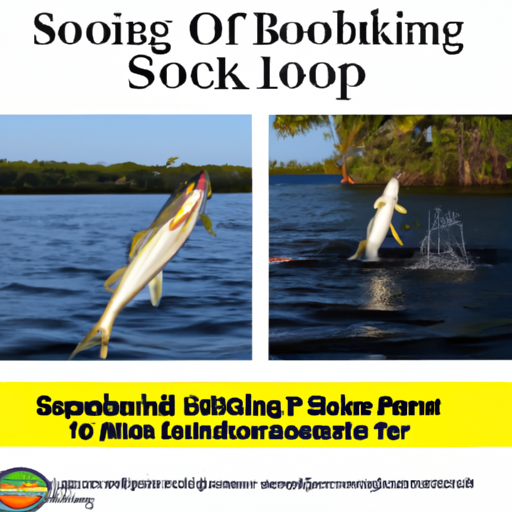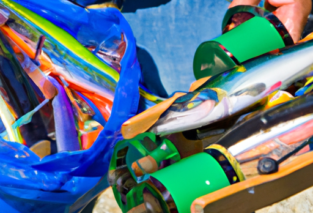Are you a snook angler looking to improve your fishing skills? Look no further! “Can You Go Snook Fishing: Tips and Techniques for Snook Anglers” is the ultimate guide that will take your snook fishing adventures to the next level. Packed with valuable tips and insider techniques, this comprehensive resource will provide you with all the knowledge you need to successfully catch snook. Whether you are a beginner or a seasoned angler, this book is your go-to companion for mastering the art of snook fishing. Get ready to reel in those trophy-sized snook with confidence!

Choosing the Right Equipment
When it comes to snook fishing, choosing the right equipment is crucial for a successful and enjoyable experience. Selecting the right rod, choosing the proper reel, and picking the right line are all important factors to consider.
Selecting the Right Rod
When selecting a rod for snook fishing, it’s important to consider the fishing conditions and the size of the snook you are targeting. A medium to a medium-heavy action rod is generally a good choice, as it provides the strength and flexibility needed to handle the powerful strikes and runs of these fish. Additionally, a rod with a length between 7 to 8 feet allows for better casting distance and control.
Choosing the Proper Reel
Choosing the right reel is equally important. A quality spinning reel in the 3000 to 4000 size range is typically preferred by snook anglers. Look for reels with a high gear ratio to enable a fast retrieval rate. It’s also important to choose a reel with a smooth drag system to combat the strong runs of the snook.
Picking the Right Line
Selecting the right line is often a overlooked aspect of snook fishing, but it can greatly impact your success. A braided line with a test strength between 20 to 30 pounds is recommended. Braided lines have a high strength-to-diameter ratio, allowing for better sensitivity and increased casting distance. Additionally, the low stretch of braided lines improves hook sets, which is especially crucial when snook fishing.
Understanding Snook Behavior
In order to effectively catch snook, it’s important to have a good understanding of their behavior. This includes knowing their habitat, understanding their feeding patterns, and recognizing their seasonal movements.
Knowing their Habitat
Snook can be found in a variety of habitats, including mangrove shorelines, sandy beaches, estuaries, and even offshore structures. They are typically found in areas with plenty of cover, such as submerged structure or docks. Understanding the preferred habitat of snook is key to locating them and increasing your chances of a successful catch.
Understanding their Feeding Patterns
Snook are voracious predators and have a varied diet that consists of baitfish, shrimp, and crustaceans. They are most active during low-light conditions, such as dawn and dusk, when their prey is also more active. Understanding their feeding patterns can help you determine the best times and locations to target snook.
Recognizing Seasonal Movements
Snook exhibit seasonal movements, especially in response to changing water temperatures. During the warmer months, they can be found in the shallower waters, such as the flats and backcountry areas. As the water cools down during the winter, snook tend to move to deeper channels and nearshore waters. Recognizing these seasonal movements allows you to adjust your fishing strategies accordingly.
Locating Snook
Locating snook is a crucial step in catching them. Targeting inshore waters, identifying snook hotspots, and using fish finders and technology can all help in locating these elusive fish.
Targeting Inshore Waters
Snook are primarily an inshore species, so targeting inshore waters is your best bet for finding them. Look for areas with a mix of structure, such as mangroves, docks, oyster bars, and grass beds. These areas provide ambush points for snook to feed and seek cover.
Identifying Snook Hotspots
Snook tend to concentrate in certain areas, known as snook hotspots. These can include creek mouths, deep holes, potholes on the flats, and areas with strong tidal flow. Look for signs of baitfish activity, such as jumping mullet or diving birds, as snook are often found in close proximity to their prey.
Using Fish Finders and Technology
Fish finders and other technological tools can be incredibly helpful in locating snook. Utilize your fish finder to identify drop-offs, submerged structure, or schools of baitfish that may indicate the presence of snook. Additionally, apps and websites that provide real-time weather and tidal information can help you plan your fishing trips more effectively.

Bait and Lure Selection
Choosing the right bait or lure is crucial for enticing snook to bite. Whether you prefer live bait or artificial lures, understanding the different options and matching the hatch will greatly increase your chances of success.
Choosing Live Bait
Live bait is a popular choice among snook anglers as it closely mimics the natural prey of these fish. Some commonly used live baits for snook fishing include pinfish, mullet, shrimp, and pilchards. Use a cast net or purchase live bait from a local tackle shop to ensure you have a fresh and lively bait.
Selecting Artificial Lures
Artificial lures can be equally effective in enticing snook strikes. Some popular lure options for snook fishing include soft plastic jerkbaits, topwater plugs, and spoons. The key is to choose lures that closely resemble the baitfish or crustaceans that snook feed on. Experiment with different colors, sizes, and retrieve speeds to find what works best in your fishing area.
Matching the Hatch
Matching the hatch refers to selecting bait or lures that closely resemble the natural prey available to snook at a particular time and location. Observing the behavior of baitfish in the area and choosing bait or lures that mimic their size, shape, and color can greatly increase your chances of enticing a snook to strike.
Casting Techniques
Mastering different casting techniques is essential for effectively targeting snook. Whether you’re casting from shore or a boat, practicing the basic cast, utilizing different casting methods, and leveraging stealthy approaches can make a significant difference.
Mastering the Basic Cast
The basic cast, also known as the overhead cast, is the foundation of all casting techniques. Practice your casting accuracy, distance, and control by using proper rod and reel positioning, smooth acceleration, and precise release. This will help you accurately place your bait or lure in the desired target area.
Utilizing Different Casting Methods
Different casting methods can be employed to reach specific areas or achieve certain presentations. Techniques such as the roll cast, sidearm cast, and pitch cast can be useful in tight areas or when you want to make shorter, more precise casts. Familiarize yourself with these casting methods and practice them to expand your fishing opportunities.
Leveraging Stealthy Approaches
Snook are known for their wariness and can be easily spooked by noise and disturbances. To increase your chances of success, utilize stealthy approaches when casting to snook. Avoid loud noises, move slowly and quietly, and make long, accurate casts to avoid alarming the fish.
Playing and Landing Snook
Once you’ve hooked a snook, successfully playing and landing it requires proper techniques to prevent the fish from breaking off or escaping.
Maintaining Proper Tension
Snook are powerful fighters and can make sudden, strong runs. It’s essential to maintain proper tension on the line to prevent it from breaking or the hook from pulling out. Keep your rod tip up and apply steady pressure while keeping a balance between the line tension and the snook’s resistance.
Reacting to Initial Strikes
When a snook strikes, it often does so with great force. Be prepared to react quickly by tightening your line and setting the hook firmly. A sharp hookset is essential to ensure the hook is securely embedded in the fish’s mouth.
Managing Snook’s Strong Runs
Snook are known for their strong runs, and it’s important to manage these runs properly to avoid line breakage. Keep your drag properly adjusted to allow the snook to make its initial run while still maintaining control. Apply steady pressure and let the fish tire itself out before attempting to bring it closer to the boat or shore.
Techniques for Catch and Release
Catch and release is an important practice to ensure the sustainability of the snook population. Using circle hooks, avoiding exhaustion, and reviving and releasing snook properly are all crucial techniques to minimize harm to the fish and maximize their chances of survival.
Using Circle Hooks
Using circle hooks is highly recommended for catch and release fishing. Circle hooks are designed to hook the fish in the corner of the mouth, reducing the chances of deep hooking and internal injuries. They are also easier to remove, minimizing harm to the fish.
Avoiding Exhaustion
When fighting a snook, it’s important to do so efficiently to avoid exhausting the fish. A worn-out fish is more susceptible to predation and less likely to survive after release. Apply steady pressure and minimize the fight time to ensure the snook’s energy reserves are conserved.
Reviving and Releasing Snook Properly
Reviving and releasing a snook properly greatly increases its chances of survival. Keep the fish in the water as much as possible during the release process and support it horizontally to avoid damage to the internal organs. Allow the snook to regain its strength by gently moving it back and forth in the water until it swims away on its own.
Snook Fishing Regulations
Before heading out to fish for snook, it’s important to familiarize yourself with the fishing regulations in your area. This includes knowing the size and bag limits, understanding seasonal closures, and staying updated with any changes to the regulations.
Knowing the Size and Bag Limits
Snook fishing regulations typically include size limits and bag limits, which vary depending on the location and the specific season. Familiarize yourself with the current regulations in your area to ensure you are in compliance and to help protect the snook population.
Understanding Seasonal Closures
Many areas implement seasonal closures to protect the snook during vulnerable times, such as spawning periods. It’s important to be aware of these closures and avoid fishing for snook during these times to contribute to the conservation of the species.
Staying Updated with Regulations
Fishing regulations can change, so it’s important to stay updated with the latest regulations in your area. Check with local fish and wildlife agencies, read fishing guides, or visit their websites to ensure you are fishing within the legal boundaries.
Weather and Tides
The weather and tides can significantly impact snook fishing success. Considering the impact of weather, understanding tidal movements, and fishing during optimal conditions can greatly increase your chances of a productive fishing trip.
Considering the Impact of Weather
Snook are affected by changes in weather, such as temperature, wind, and barometric pressure. They are more active during lower light conditions, such as early morning or evening, and may be less active during hot or cold fronts. Pay attention to weather forecasts and plan your fishing trips accordingly to take advantage of the best conditions.
Understanding Tidal Movements
Tidal movements play a crucial role in snook fishing. Snook often feed aggressively during tidal changes when the water movement stirs up baitfish and other prey. Understanding the tidal patterns in your fishing area and targeting the incoming or outgoing tide can increase your chances of locating feeding snook.
Fishing during Optimal Conditions
Fishing during optimal conditions can significantly improve your chances of success. Consider factors such as water clarity, water temperature, and the presence of baitfish when planning your fishing trips. Snook are more likely to feed when the conditions are favorable, so aim to fish during times when the conditions are in your favor.
Additional Tips and Tricks
In addition to the main aspects of snook fishing, there are several additional tips and tricks that can enhance your chances of success.
Night Fishing for Snook
Night fishing for snook can be incredibly productive. Snook are nocturnal feeders and tend to be more active when the sun goes down. Use lighted docks, artificial underwater lights, or a headlamp to attract baitfish and increase your chances of catching snook after dark.
Using Chum to Attract Snook
Using chum is a technique that can help attract snook to your fishing spot. Chum consists of small pieces of cut bait or fish food that is dispersed in the water. It creates a scent trail that can draw snook towards your bait or lure. Use a chum bag or a mesh bag filled with small pieces of fish and hang it in the water near your fishing area.
Trying Different Retrieve Speeds
Snook can be finicky eaters, so don’t be afraid to experiment with different retrieve speeds. Sometimes a slow, steady retrieve is more effective, while other times a fast and erratic retrieve may entice a strike. Vary your retrieve speeds and see what works best on any given day.
In conclusion, snook fishing can be an exciting and rewarding experience for anglers. By choosing the right equipment, understanding snook behavior, locating snook, selecting the right bait or lures, mastering casting techniques, playing and landing snook properly, practicing catch and release techniques, following fishing regulations, considering weather and tides, and utilizing additional tips and tricks, you can greatly increase your chances of a successful snook fishing adventure. Remember to always practice responsible fishing and conservation efforts to ensure the sustainability of the snook population for future generations of anglers.





